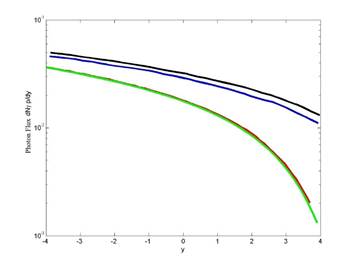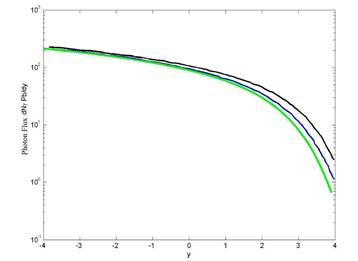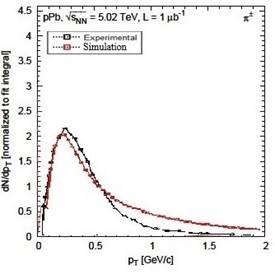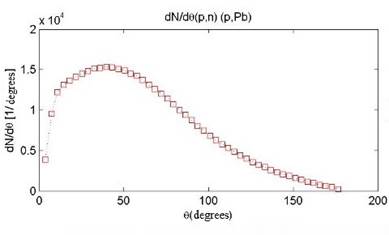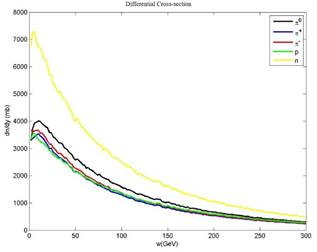I. Introduction
The electromagnetic excitation of the nucleus (
The collisions between hadrons can be split into three categories taking into account the parameter of impact b. In the first category the collision occurs with a geometric overlap of hadrons and receives the name of central collision, where the impact parameter is minor than the sum of the radios of both particles b<R1+R2 (R1 and R2 are the radios of particle 1 and 2 respectively). When the parameter of impact is b≈R1+R2, collisions are referred as peripheral, and if the sum of both radios is b>R1+R2, ultra-peripheral. In the last case, because there is not overlap between the interacting particles, the strong interaction is inhibited.
In the present work the photonuclear interactions in heavy ions are studied, analyzing their contribution to the production of hadrons in ultra-peripheral symmetric and asymmetric collisions. To accomplish this goal a methodology for the simulation of photonuclear interactions in ultra-peripheral collisions that includes the weigh-in of the spectrum of photons is developed with the code CRISP. The mesonic resonances at energies of the incident photon under 1 GeV are explored. Getting the weigh-ins of the spectrums of Weizsäcker-Williams for the ultra-peripheral collisions symmetric (197Au-197Au,
Materials methods and results
II. Methodology of Monte Carlo’s Simulation for Ultra-peripheral Collisions
Monte Carlo’s simulation for ultra-peripheral collisions, symmetric and asymmetric, consists of two steps [3]. First, obtaining the fluxes of virtual photons as a function of the energy of the photon and the impact parameter. The second step consists in simulating γx and γA interactions.
In the process of conception of the simulation it is important to take into account that the code CRISP doesn’t have implemented the interaction of a spectrum of photons with a nucleus, but of a monochromatic photon with the target.
The simulations are carried out taking into account the following steps:
The energetic spectrum of the photons coming from one of the nucleus of 197Au in 197Au- 197Au is split into 2 GeV’s 150 energetic steps with 10000 effective cascades.
The energetic spectrum of the photons coming from the proton in p-208Pb is split into 3 energetic ranges.
(0-1.615) GeV, with an energetic step of 0,030 GeV and 1000 effective cascades.
(2-50) GeV, with an energetic step of 1 GeV and 10000 effective cascades.
(66.5-940.5) GeV, with an energetic step of 19 GeV and 1000 effective cascades.
The interaction of monochromatic photons in γ-197Au and γ-208Pb with energy value of the top end of the corresponding energy bin is simulated.
The photoproduction cross-section of particles for each Eγ value is obtained.
All the contributions are added up to obtain the total cross-section of the photonuclear interaction:
III. Simulation of the ultra-peripheral symmetric collision
197
Au-
197
Au at
A. Obtaining of the flux of virtual photons for the 197Au nucleus
The spectrum of virtual photons of the 197Au nucleus was obtained in terms of the rapidity of the
The following expression appears in review papers for the photon flux of a fast moving charged particle:
where
were
IV. Simulation of the ultra-peripheral asymmetric p-
208
Pb collision at
First, the fluxes of virtual photons from the proton and lead, reported in literature [4], that have a better precision, are compared with the calculus performed in this contribution (4). In the case of the proton, Guzey and Zhalov use the dipole approximation of FZ(Q2), and with this:
Also, it is used the approximated expression:
where:
The following figure represents the flux of photons Nγ/p of the ultra-relativistic proton as a function of the rapidity of the J/ψ meson:
In the figure the exact calculation of the equation representing the flux of a relativistic charged particle (3) is given by the blue curve and the approximate result from (6) by the black curve. In order to add more accuracy to the determination of the flux of photons, Guzey and Zhalov took into account the suppression of the strong interaction between the colliding particles. The resulting flux of photons for the proton is calculated in the following way:
where σnn is the total nucleon-nucleon cross-section (σnn=90mb at
Nγ/Pb is also presented including the approximation (4) for the Pb nucleus, in green color. First, the blue curve correspond to the calculations performed turning down the suppression of the nuclear strong interaction by means of the placement of
A. Production of light mesons. Resonances
The cross-section of production of π0 mesons as a function of the incident photon’s energy for the reaction: γ+p→p+π0 is studied. A resonance is observed for 340 MeV’s energy of the incident photon in the laboratory frame, corresponding to 1232 MeV’s energy in the center of momentum frame for γ−p.
The study of the incoherent γ−p mechanism is worthy of notice because it initiates the process of intranuclear cascade. The same resonance obtained in the simulation confirms the importance of the ∆(1232 MeV) resonance in the production of pions, in agreement with the experimental results reported in literature [5].
B.
The
It is observed that, the multicollisional dynamics implemented at CRISP, initiated by photonuclear interactions, is capable of reproducing with an acceptable precision the
Another magnitude of concern that allows the identification of particles when an experimental spectrum is analysed is the invariant mass. In a range between 100 MeV/c2 and 200 MeV/c2 the invariant mass was obtained in the simulation and the π resonance observed.
The K mesons, with a mass of approximately 500 MeV/c2, are the lighter strange mesons, that can be produced in reactions of the type:
The cross-section of these processes is of the range of millibarn, typical of processes that involve strong nuclear interaction, however, K mesons decay with a life time of 10−8 s, characteristic of the weak interaction. This is why different values from zero of strangeness are assigned to them. The invariant mass spectrum eliminating the peak of the π mesons was obtained in the simulation.
Two resonances were observed: 770 MeV/c2 and 498 MeV/c2, corresponding to the formation of ρ and K mesons, respectively, in agreement with experimental results.
C. Angular distribution and cross-section
In the incoherent processes, nucleus splitting can occur, with preferential emission of neutrons in the same direction of the incident photons. The figure shows the angular distribution of neutrons obtained in the simulation. It can be observed the expected maximum in the forward direction.
The neutron, proton and pion γ +197Au photonuclear cross-sections were calculated. The cross-sections increase with the energy of the incident photon until a maximum value. From this point on, the cross-sections decrease as a result of the opening of other channels at higher energies.
The following figure shows the differential cross-sections, including the weigh-in of the spectrum for 197Au. The inclusion of the weigh-in of the spectrum enables affirming that it has been passed from exploring the production of particles making photons collide with target nucleus, to the study of a process of ultra-peripheral nature, where the electromagnetic field of one of the nuclei has excited the other nucleus, causing emission of particles. When the weigh-in is included the higher energies are strongly suppressed, which indicates that the weigh-in of the spectrum is crucial if one wants to do comparisons between simulation and experiment in ultra-peripheral collisions.
VI. Conclusions
In the present work the production of hadrons in photonuclear interactions γ-A of ultra-peripheral collisions is characterized. Firstly, the interaction of real photons with protons as target was simulated and the mesonic resonances for energies under 1 GeV were observed, obtaining in the simulation results in agreement with experimental data. Also a methodology for the study of ultra-peripheral collisions using the code CRISP is developed. The classical Weizsäcker-Williams method was implemented in MATLAB, for the symmetric case 197Au-197Au and asymmetric p-208Pb, comparing it with more precise approximations reported in literature. It allowed validating the weigh-in performed in this contribution, and counting with the spectrums of the gold nucleus, the proton and the lead nucleus.
For the study of the ultra-peripheral asymmetric collision p-208Pb at
The previously analysed results allow to confirm the efficiency of the Method of Virtual Photons to describe the production of hadrons due to the electromagnetic excitation of the nucleus, and the importance of the inclusion of the weigh-in of the spectrum. In the interest of completing the characterization of the ultra-peripheral asymmetric collision p-208Pb, it is recommended to study the γ-p interactions, in all the energetic range of incidence of the incoming photons from the lead nucleus. It would allow extending this work including the production of heavy mesons because, as it was said previously, its majority rate of production in p-208Pb is in the γ-p processes. For this, the research has to be done with a Monte Carlo simulator adequately describing binary interactions at higher energies. Furthermore, it could be extended taking into account the availability of experimental results, to other ultra-peripheral asymmetric collisions as d-Au, d-Pb, etc.













